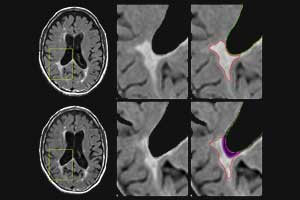- Home
- Editorial
- News
- Practice Guidelines
- Anesthesiology Guidelines
- Cancer Guidelines
- Cardiac Sciences Guidelines
- Critical Care Guidelines
- Dentistry Guidelines
- Dermatology Guidelines
- Diabetes and Endo Guidelines
- Diagnostics Guidelines
- ENT Guidelines
- Featured Practice Guidelines
- Gastroenterology Guidelines
- Geriatrics Guidelines
- Medicine Guidelines
- Nephrology Guidelines
- Neurosciences Guidelines
- Obs and Gynae Guidelines
- Ophthalmology Guidelines
- Orthopaedics Guidelines
- Paediatrics Guidelines
- Psychiatry Guidelines
- Pulmonology Guidelines
- Radiology Guidelines
- Surgery Guidelines
- Urology Guidelines
Atrophied brain lesions in MRI indicate progression of Multiple Sclerosis : Study

For decades, the appearance of new or expanding brain lesions on magnetic resonance imaging (MRI) scans was interpreted by clinicians as a sign for worsening of multiple sclerosis (MS). Now, a new study published in the Journal of Neuroimaging has found that the disappearance or atrophy of these lesions into the cerebrospinal fluid (CSF) might be a better imaging marker for MS progression.
The five-year study was conducted by Robert Zivadinov, a professor of neurology at University at Buffalo, and colleagues to evaluate the independent predictive value of atrophied lesion volume for multiple sclerosis.
Brain lesions, in general, is a sign of damage to the brain, such as physical trauma, a stroke, normal aging or chronic disease. Patients with MS receive MRI scans as part of their routine care so that doctors can track the appearance of new lesions and the enlargement of existing ones, typically seen as indicators of disease progression. Approval by the Food and Drug Administration for new MS drugs typically depends on the drug’s ability to reduce the number of brain lesions over 24 months.
Multiple sclerosis is characterized by the loss of myelin sheaths surrounding axons in the brain and disrupting the brain’s ability to send and receive neuronal messages. The growth of new myelin sheaths around axons may demonstrate that some brain tissue has been repaired spontaneously or as the result of medication.
For the study, a total of 192 patients (18 clinically isolated syndrome, 126 relapsing‐remitting MS, and 48 progressive) received 3 Tesla MRI at baseline and 5 years. Lesions were quantified at baseline, and new/enlarging lesion volumes were calculated over the study interval. Atrophied lesion volume was calculated by combining baseline lesion masks with follow‐up SIENAX‐derived cerebrospinal fluid partial volume maps. Measures were compared between disease subgroups, and correlations with disability change (Expanded Disability Status Scale [EDSS]) were evaluated. Hierarchical regression was employed to determine the unique additive value of atrophied lesion volume.
“Using the appearance of new brain lesions and the enlargement of existing ones as the indicator of disease progression, there was no sign of who would develop disability during five or 10 years of follow-up, but when we used the amount of brain lesion volume that had atrophied, we could predict within the first six months who would develop disability progression over long-term follow-up," said Zivadinov.
“The big news here is that we did the opposite of what has been done in the last 40 years,” said Michael G. Dwyer, assistant professor of neurology and bioinformatics in the Jacobs School and first author on the five-year study in the Journal of Neuroimaging. “Instead of looking at new brain lesions, we looked at the phenomenon of brain lesions disappearing into the cerebrospinal fluid.”
“We didn’t find a correlation between people who developed more or larger lesions and developed increased disability,” said Dwyer, “but we did find that atrophy of lesion volume predicted the development of more physical disability.”
Key Findings:
- While patients with relapsing-remitting MS showed the highest amount of new lesions during the study, patients with progressive MS — the most severe subtype — had the most accelerated volume of brain lesion atrophy, this indicates that the new imaging biomarker could be particularly important in transitional phases between relapsing and progressive MS subtypes.
- Lesion volume increased in the initial phases of the disease and then plateaus in the later stages because many of these lesions are disappearing, turning into the CSF.
- Atrophied brain lesions were a more robust predictor of disability progression than the development of whole brain atrophy itself, the most accepted biomarker of neurodegeneration in MS.
“Our data suggest that atrophied lesions are not a small, secondary phenomenon in MS, and instead indicate that they may play an increasingly important role in predicting who will develop a more severe and progressive disease,” said Zivadinov.
Based on the study, the authors concluded that atrophied lesion volume is a unique and clinically relevant imaging marker in MS, with particular promise in progressive MS.
For further information click on the link: https://doi.org/10.1111/jon.12527

Disclaimer: This site is primarily intended for healthcare professionals. Any content/information on this website does not replace the advice of medical and/or health professionals and should not be construed as medical/diagnostic advice/endorsement or prescription. Use of this site is subject to our terms of use, privacy policy, advertisement policy. © 2020 Minerva Medical Treatment Pvt Ltd